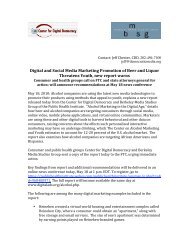"Interactive Food & Beverage Marketing" (PDF)
"Interactive Food & Beverage Marketing" (PDF)
"Interactive Food & Beverage Marketing" (PDF)
Create successful ePaper yourself
Turn your PDF publications into a flip-book with our unique Google optimized e-Paper software.
[S]oftware developers<br />
explained how they<br />
purposefully create<br />
games to make them<br />
“in sync with the<br />
brand,” ensuring that<br />
images players see in<br />
the game are similar<br />
to what “they see in<br />
the supermarket<br />
aisle…[and on TV]<br />
Saturday morning.”<br />
<strong>Interactive</strong> <strong>Food</strong> & <strong>Beverage</strong> Marketing | The New Digital Marketing Landscape<br />
Industry analysts predict that in-game advertising will continue to grow, becoming<br />
a dominant business model for most games in the future. Keynoting the 2006 Game<br />
Developers Conference, Kevin Browne, Microsoft’s general manager of its Xbox new<br />
media and franchise development, told participants:<br />
When you think about it, a fairly small shift in advertiser behavior<br />
could replace all the revenue that we generate today. We could be a<br />
totally ad-funded business if we could figure out how to do that. We<br />
could double the size of our industry by 2010 by finding the right<br />
mix. 221<br />
Marketing is already shaping how new games are designed. At a recent conference<br />
on interactive advertising, software developers explained how they purposefully create<br />
games to make them “in sync with the brand,” ensuring that images players see in<br />
the game are similar to what “they see in the supermarket aisle…[and on TV] Saturday<br />
morning.” Games must always be “addictive,” and should include a “viral component” as<br />
a “persistent navigation element” that is always a part of the experience, thus giving players<br />
“the opportunity to contact friends and urge them to play.” The more rooms built into<br />
a game, the more opportunities players will have to “interact with the brand,” enabling<br />
the game to foster “deeper engagement with users.” Finally, games need to be designed<br />
in such a way that they can be “continually updated” and facilitate ongoing data collection<br />
and analysis so that companies can know which “elements are being used.” 222<br />
With funding from advertisers, the next generation of interactive games could be even<br />
more powerful vehicles for engaging consumers with brands. Digital technology, including<br />
broadband, now permits thousands of gamers to “simultaneously interact in a game<br />
world connected via the Internet,” according to a June 2006 report from the ad firm<br />
Universal McCann. “Massively Multiplayer Online Games” (MMOG) already generate $350<br />
billion a year, and are “the fastest growing entertainment segment in the world,” according<br />
to the report. Combining the worlds of virtual reality, gaming, and targeted advertising,<br />
MMOGs will increasingly become part of the advertisers’ arsenal “to engage with a hardto-reach<br />
youth demographic.” 223 As IGA Worldwide executive Justin Townsend recently<br />
explained, “The next generation of ads will be 3-D interactive ads—clicking on an appealing<br />
billboard to receive an email for that brand, for instance. There’s a big difference<br />
between image-based advertising and transactional advertising. The whole concept of<br />
clicking on a billboard will shift [in-game advertising] to a transactional ad medium.” 224<br />
51









